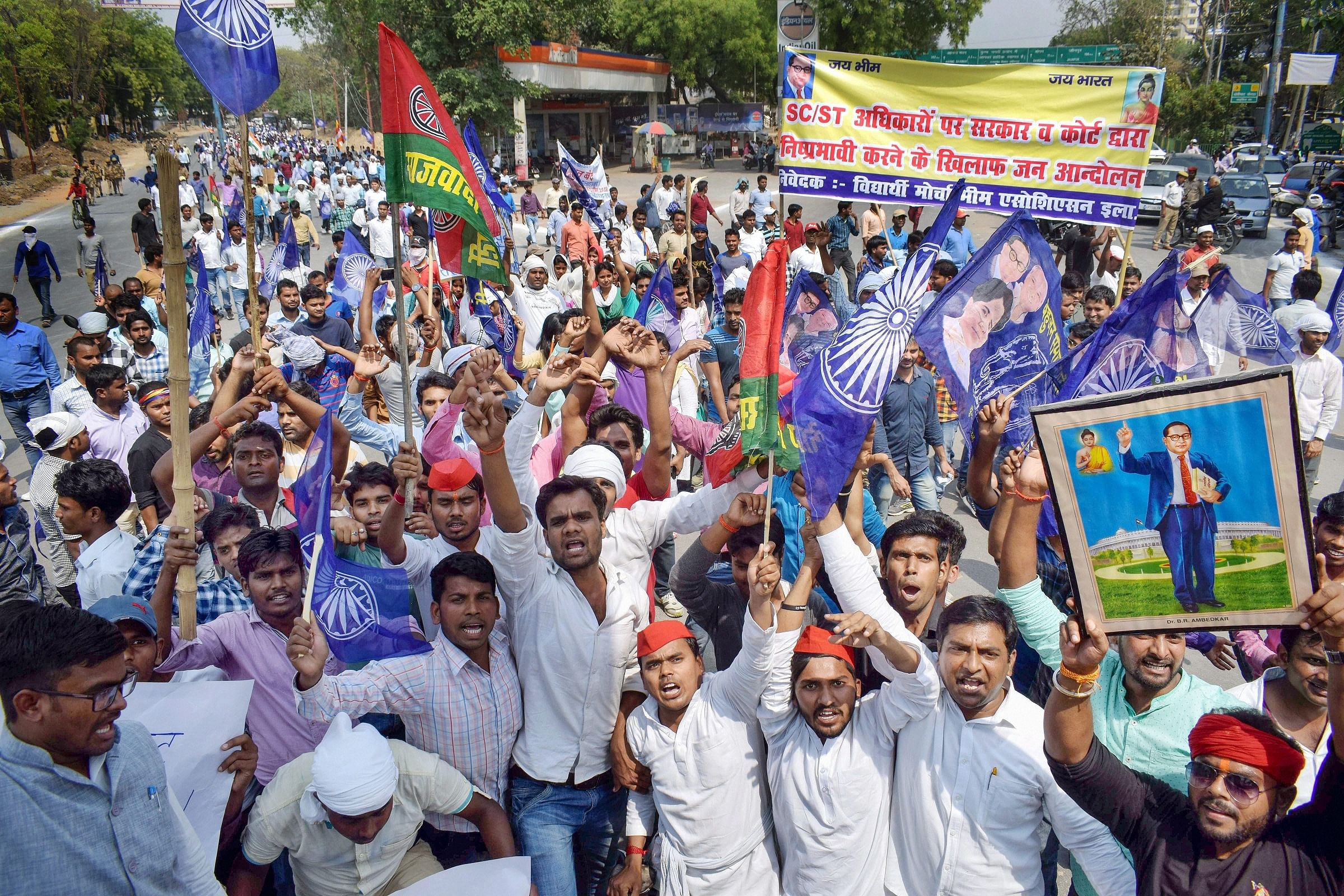
The Dalit challenge stares the Modi government in the face as it nears completion of its five-year term in office.
A week before Dalit organisations were to organise a Bharat Bandh on August 9, seeking nullification of the Supreme Court order ‘diluting’ the
SC/ST Act, the union cabinet on August 1 approved a new bill to restore the provisions of the Act and negate the apex court’s judgement. The government swiftly brought it to parliament and had it passed by the Lok Sabha. The Rajya Sabha is expected to pass it, too, without trouble. The Modi government clearly bowed to pressure from Dalit groups.
Dalit anger, which has from time to time manifested itself in varying degrees over various issues and in different parts of the country in the last four years has alarmed not only NDA allies but even the Dalit MPs of the BJP.
Be it in Prime Minister Narendra Modi’s home state of Gujarat or the BJP’s key support states, including Maharashtra (where the RSS is headquartered) and cow-belt states of Uttar Pradesh and Bihar, the Dalit challenge has always confronted the BJP. In January, for instance, Dalit anger spilled over into the streets in nine districts of BJP-ruled Maharashtra following Hindutva groups’ violence against them in Bhima Koregaon in Pune.
A massive Dalit upsurge after incidents like the flogging of Dalit youths in Una, Gujarat, Dalit student Rohith Vemula’s suicide in Hyderabad University or the Thakur-Dalit clashes in Saharanpur in UP have also pointed to the limits of the BJP’s Dalit outreach.
The reaction by Dalit groups when the Yogi Adityanath government in UP decided to add ‘Ramji’ to BR Ambedkar’s name in all official records was another eye-opener. The rise of young Dalit leaders like Jignesh Mevani in Gujarat in the wake of the flogging by ‘gau rakshaks’ of four Dalits for skinning the carcass of a dead cow in Una in July 2016 or for that matter Dalit consolidation under Chandrasekhar Azad, who founded the Bheem Army in UP, are also cases in point.
“The problem is that even when a small incident happens, the Dalits’ distrust of the BJP comes to the fore. Similar incidents during Congress regime would not lead to such massive consolidation of the community against the government. Somehow, every small incident leads to a flare up. The trouble is all the more for allies or leaders whose core constituency is the Dalit,” says a senior minister in the Modi government.
This is so even when the BJP has the maximum number — 40 — of Dalit MPs in the Lok Sabha. Also, the BJP got huge support from Dalits in Bihar and non-Jatav Dalits in UP during the 2014 Lok Sabha polls.
The Dalit MPs in the BJP are restive. On April 1, Savitri Bai Phule, the party’s firebrand MP from Bahraich, held an independent rally in Lucknow, called ‘Samvidhan Bachao Aarakshan Bachao (Save Constitution, Save Reservation)’. She said she would not allow anyone to tinker with reservations, no matter whether she remained an MP or not.
Yashwant Singh, BJP MP from Nageen, on April 2 wrote to PM Modi alleging that the government had done nothing for Dalits and that the party’s Dalit MPs were finding it difficult to face community members.
On April 5, Chhote Lal Kharwar, the MP from Robertsganj, wrote to Modi slamming Chief Minister Yogi Adityanath for the treatment meted out to him. Around the same time, another party MP, Ashok Dohrey, wrote to the PM alleging that the state police were harassing Dalits and framing them in baseless cases out of vengeance.
Young Dalit leader Udit Raj, who joined the BJP ahead of 2014 Lok Sabha polls, recently went hammer and tongs against the government and questioned the rationale of appointing as chairman of the National Green Tribunal Justice AK Goel, the judge who had delivered the ruling ‘diluting’ the SC/ST Act. He warned that the distance between the Dalit communities and the ministers of the government was increasing.
Image crisis
Union minister and NDA ally Ram Vilas Paswan’s son Chirag issued an ultimatum last week to the government to bring “either an ordinance or a legislation” to negate Justice Goel’s order.
Other allies, such as Om Prakash Rajbhar, who heads the Suheldev Bharatiya Samaj Party (SBSP) in UP, have been constantly attacking the Yogi government over the last year.
In July, Rajbhar, who is a UP cabinet minister, sat on dharna against the functioning of the Yogi government and blamed the chief minister for the BJP’s defeat in Lok Sabha by-polls in Gorakhpur, Phulpur and Kairana, sending the BJP into a tizzy trying to mollify him.
In Bihar, former CM Jitan Ram Manjhi, whose party Hindustan Awam Morcha (Secular) had allied with the BJP during the last Lok Sabha polls, deserted the NDA in February this year and joined the alliance with Lalu Prasad’s RJD and Congress. Manjhi hails from the Mahadalit Musahar (mouse-eater) community.
These developments do not augur well for the BJP which, under Modi, has attempted to shed its ‘Brahmin-Baniya party’ tag and cultivate a pro-Dalit, pro-OBC image.
In the 2014 polls, it got nearly a quarter of the total Dalit votes, something that the Congress used to get in the past. The BJP made in-roads into the Dalit vote base of both Congress and BSP.
Facing Dalit outrage, the party now argues that no government has given so much importance to Ambedkar’s legacy as the Modi government and cites the construction of memorials and the institution of university chairs in his name. They also point to the appointment of Ram Nath Kovind as President.
But it remains to be seen how Dalits, who make up some 17% of the nation’s population, respond to the BJP’s claims in 2019. Uttar Pradesh, with 80 Lok Sabha seats, is crucial, with a Dalit vote share of 20.5%.
